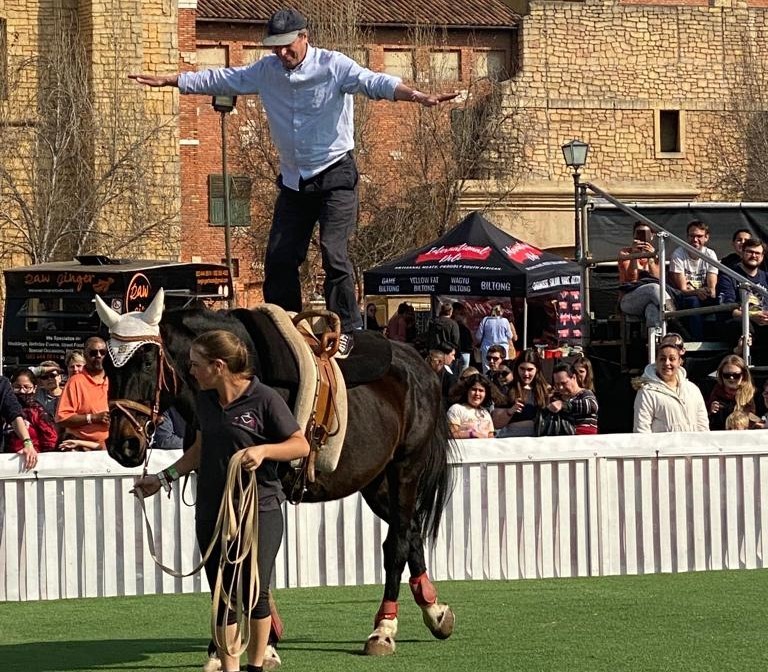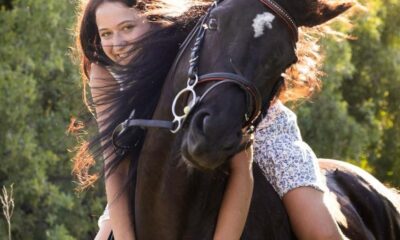
Sport

Septuagenarian vaulter gets back on the horse
Johannesburg septuagenarian Fred Oppenheimer is the last horse vaulter standing of the five Jewish athletes who showcased their gymnastic skills on top of a horse at the Welkom Show in 1968.
Oppenheimer and the other four were children when featured in a photograph in the South African Jewish Times in March 1968, and the only amateur horse vaulters in the country at the time.
“Michele Isserow passed away; Linda Sonntag is in America; and Jack Hochfeld [absent when the photo was taken] is in Australia. Sandra Labe, as far as I know, lives in Johannesburg. I lost touch with Rudolf Eastern. They don’t do vaulting anymore,” Oppenheimer says.
Having done horse vaulting, described as gymnastics on horseback, for about a decade, Oppenheimer stopped participating in the sport in 1973 at the age of 23. He never did it again until he turned 70 three years ago.
“We stopped because we were at varsity or working, and the team kind of dissolved, everybody went their own way,” Oppenheimer says. “In 2020, I decided that if I didn’t do it now, I would never go back. I found a place called Randjesfontein Vaulting Club. It does competitions among the different riding schools.”
The vaulters at the club are mainly youngsters between the ages of five and 20. “But there’s a lady, Moe Fitzgerald, who is 79 and still does vaulting. So it doesn’t have to be kids, but we’re the only two seniors, if you put it that way.”
Oppenheimer was riding horses at Blue Hills Riding School in Midrand, when the school’s circus man, Harry Carre, introduced the riders to vaulting in 1964. “What I liked about it was more about doing gymnastics on the horse as opposed to having to control the horse. We worked in a ring with a ringmaster who had a lunge rein attached to the horse. He would make the horse go around for us at a canter. We would then go into the centre of the ring and run up to the horse, jump on top, and do various routines.”
Oppenheimer has footage of himself vaulting in his younger days. While the horse cantered around, he performed acrobatics like standing, doing a headstand, kneeling, twirling a hula hoop, and the wheelbarrow, which involved two people on the same horse.
He was inspired to return to the sport by his love for it. “You don’t have to be the best horse rider, you don’t have to ride the horse as such, somebody controls the horse for you, and you can get creative. That’s what I enjoy, doing my own thing, as opposed to taking the horse jumping. All that stuff is quite expensive. In other words, what’s nice about this is that you can have one horse, one person running it for you, and you can have, say, four or five vaulters doing it in one hour. You have some freedom because you don’t have a saddle. You have a mat on the horse’s back, and you have a strap with two handles, so you use that strap with handles to get on.”
Horse vaulting was featured in the Roman Games about 2 000 years ago, and the sport was used to train cavalry soldiers in ancient Greece. It was also used as a form of entertainment at the Roman Colosseum. In the Middle Ages, it was used to train horses for battle and for entertainment at the royal courts.
Vaulting has been included as an official sport at the 2032 Brisbane Olympics, having previously featured at the 1920 Olympic Games in Antwerp and appearing as an artistic demonstration at two other Games.
The sport took off in South Africa in 2005 after the first international coach came to the country.
The Randjesfontein Vaulting Club, run by Shea Wright, has a horse for vaulters, and holds vaulting shows in Midrand. “It’s pretty popular,” Oppenheimer says. “You might easily get 50 competitors at a show. You have to do a particular routine, which is compulsory, and then freestyle. The kids dress up, so it’s quite fun for them. They do their routine to music.
“Back in the day, we could do any trick we wanted and we would have, say, two people on a horse. Most of the tricks would have been done at a canter because a trot is too bouncy for vaulting. We did certain things at a walk but mainly at a canter. There were no competitions. We were, I think, the only team doing vaulting, and we would give displays at the Indoor Horse Show at the Rand Show in Johannesburg. Our vaulting school gives a vaulting display at Montecasino once a year at a pet expo.”
Oppenheimer practised horse vaulting by just jumping on the horse and honing his tricks. “Today,” he says, “they have what they call a barrel, a 44 gallon drum, to practise on.”
Born in Orchards, Johannesburg, Oppenheimer went to Orange Grove Primary School and Highlands North Boys High School. “Then I went to the army for a year. They had a sports day on a Wednesday, and allowed me to go back to Johannesburg with the people who played golf, so I would trundle along with them, and I vaulted while in the army but not for the army. I studied accounting after the army. I still run my own accounting practice. I also trade in antique maps and documents as a hobby, but I’ve built it into a business.”
Oppenheimer has accumulated a collection of antique documents, certificates, indentures, military medals and seals. He has two children, Mark, an advocate specialising in hate-speech cases, and Pammi Joy, who works in the hospitality industry.






